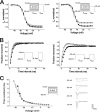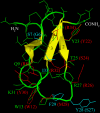Unique bell-shaped voltage-dependent modulation of Na+ channel gating by novel insect-selective toxins from the spider Agelena orientalis
- PMID: 20385552
- PMCID: PMC2881780
- DOI: 10.1074/jbc.M110.125211
Unique bell-shaped voltage-dependent modulation of Na+ channel gating by novel insect-selective toxins from the spider Agelena orientalis
Abstract
Spider venoms provide a highly valuable source of peptide toxins that act on a wide diversity of membrane-bound receptors and ion channels. In this work, we report isolation, biochemical analysis, and pharmacological characterization of a novel family of spider peptide toxins, designated beta/delta-agatoxins. These toxins consist of 36-38 amino acid residues and originate from the venom of the agelenid funnel-web spider Agelena orientalis. The presented toxins show considerable amino acid sequence similarity to other known toxins such as mu-agatoxins, curtatoxins, and delta-palutoxins-IT from the related spiders Agelenopsis aperta, Hololena curta, and Paracoelotes luctuosus. beta/delta-Agatoxins modulate the insect Na(V) channel (DmNa(V)1/tipE) in a unique manner, with both the activation and inactivation processes being affected. The voltage dependence of activation is shifted toward more hyperpolarized potentials (analogous to site 4 toxins) and a non-inactivating persistent Na(+) current is induced (site 3-like action). Interestingly, both effects take place in a voltage-dependent manner, producing a bell-shaped curve between -80 and 0 mV, and they are absent in mammalian Na(V) channels. To the best of our knowledge, this is the first detailed report of peptide toxins with such a peculiar pharmacological behavior, clearly indicating that traditional classification of toxins according to their binding sites may not be as exclusive as previously assumed.
Figures








Similar articles
-
Isolation, synthesis and pharmacological characterization of delta-palutoxins IT, novel insecticidal toxins from the spider Paracoelotes luctuosus (Amaurobiidae).Eur J Biochem. 2000 Sep;267(18):5783-95. doi: 10.1046/j.1432-1327.2000.01653.x. Eur J Biochem. 2000. PMID: 10971590
-
Insect-selective spider toxins targeting voltage-gated sodium channels.Toxicon. 2007 Mar 15;49(4):490-512. doi: 10.1016/j.toxicon.2006.11.027. Epub 2006 Dec 5. Toxicon. 2007. PMID: 17223149 Review.
-
Solution structure of two insect-specific spider toxins and their pharmacological interaction with the insect voltage-gated Na+ channel.Proteins. 2005 May 1;59(2):368-79. doi: 10.1002/prot.20424. Proteins. 2005. PMID: 15726637
-
Jingzhaotoxin-I, a novel spider neurotoxin preferentially inhibiting cardiac sodium channel inactivation.J Biol Chem. 2005 Apr 1;280(13):12069-76. doi: 10.1074/jbc.M411651200. Epub 2004 Nov 17. J Biol Chem. 2005. PMID: 15548530
-
Agatoxins: ion channel specific toxins from the American funnel web spider, Agelenopsis aperta.Toxicon. 2004 Apr;43(5):509-25. doi: 10.1016/j.toxicon.2004.02.004. Toxicon. 2004. PMID: 15066410 Review.
Cited by
-
Quo vadis venomics? A roadmap to neglected venomous invertebrates.Toxins (Basel). 2014 Dec 19;6(12):3488-551. doi: 10.3390/toxins6123488. Toxins (Basel). 2014. PMID: 25533518 Free PMC article. Review.
-
Structure and function of hainantoxin-III, a selective antagonist of neuronal tetrodotoxin-sensitive voltage-gated sodium channels isolated from the Chinese bird spider Ornithoctonus hainana.J Biol Chem. 2013 Jul 12;288(28):20392-403. doi: 10.1074/jbc.M112.426627. Epub 2013 May 23. J Biol Chem. 2013. PMID: 23703613 Free PMC article.
-
Structure and Function of FS50, a salivary protein from the flea Xenopsylla cheopis that blocks the sodium channel NaV1.5.Sci Rep. 2016 Nov 7;6:36574. doi: 10.1038/srep36574. Sci Rep. 2016. PMID: 27819327 Free PMC article.
-
The first venomous crustacean revealed by transcriptomics and functional morphology: remipede venom glands express a unique toxin cocktail dominated by enzymes and a neurotoxin.Mol Biol Evol. 2014 Jan;31(1):48-58. doi: 10.1093/molbev/mst199. Epub 2013 Oct 16. Mol Biol Evol. 2014. PMID: 24132120 Free PMC article.
-
Transcriptomic Analysis Reveals Diverse Expression of Scorpion Toxin Genes in Mesobuthus martensii.Toxins (Basel). 2024 Sep 18;16(9):399. doi: 10.3390/toxins16090399. Toxins (Basel). 2024. PMID: 39330857 Free PMC article.
References
-
- Estrada G., Villegas E., Corzo G. (2007) Nat. Prod. Rep. 24, 145–161 - PubMed
-
- Grishin E. (1999) Eur. J. Biochem. 264, 276–280 - PubMed
-
- Rash L. D., Hodgson W. C. (2002) Toxicon 40, 225–254 - PubMed
-
- Vassilevski A. A., Kozlov S. A., Grishin E. V. (2009) Biochemistry 74, 1505–1534 - PubMed
-
- Catterall W. A. (2000) Neuron 26, 13–25 - PubMed
Publication types
MeSH terms
Substances
LinkOut - more resources
Full Text Sources
Research Materials

